Key messages
- When committing resources for crops yet to emerge, consider yield potential and stored moisture in the soil profile.
- APSIM modelling was used to assess likely yields of a short to mid maturing wheat variety such as Mace after a dry summer at 7 locations in the state with emergence from May through to June.
- Yield potential varies significantly between locations and yield declines more steeply as sowing is delayed at northern locations (Mullewa, Mingenew, and Wongan Hills) than further south.
- Dry sown paddocks will emerge on opening rains and will provide the best yielding option for short-medium maturity wheat this season.
- However, if paddocks are not sown, yield potential is declining and the probability of yields over 2t/ha are declining in most locations.
- Consider locking up paddocks if they are not already sown in low rainfall districts
- If you have ameliorated your soil – it will be important to consider establishing a cover crop on those paddocks to maintain ground cover and prevent erosion in the following year.
- Consider the probability of achieving a predicted yield in your district to assist with decision on crop nutrition.
Introduction
Much of the WA wheatbelt has experienced a very dry 2018–2019 summer leaving very little stored moisture at present (DPIRD, May seasonal report 2019). Growers are still waiting for breaking rains to germinate dry sown crops and provide confidence to seed remaining paddocks. Variety choice, sowing time (Shackley et al. 2019), stored moisture and growing season rainfall are key factors influencing the yield potential of a wheat crop. Delayed seeding or emergence will shorten the growing season and reduce yield potential. Wheat crops emerging in June can still give a good yield depending on the location and if the remainder of the season is suitable (think about 2018)
This article uses the Agricultural Production Systems sIMulator (APSIM) modelling to assess likely yields of a short to mid maturing wheat variety such as Mace after a dry summer at 7 locations in the state with emergence from May through to June. The predictions are based on 43 simulations using weather data from 1975 to 2018 in which data from 15 November in the previous year until 6 May has been replaced with 2018/19 data. Soil nitrogen (N) was reset to very low levels on 15 November each year but 30kg/ha N was applied at sowing and a further 100 kg/ha N was applied 30 days after sowing to ensure N was not limiting. These yields are adjusted for damage caused by frost and heat stress.
Given the seasonal conditions experienced across the state, what is the yield potential?
Yield potential varies significantly between locations (Figure 1). At Mullewa and Merredin, the median (decile 5) yield of short to mid maturing wheat varieties such as Mace sown in June are less than 1.5 t/ha given an average season from the 6th May. Some locations, such as Gibson and Kojonup, can achieve yields greater than 2t/ha if crops are sown in the first two weeks of June given a median season after this time. Yield declines more steeply at northern locations (Mullewa, Mingenew, and Wongan Hills) as sowing is delayed than further south. Parallel simulations with normal summer rain result in higher median yields for May sowings at most locations, but the advantage of summer rain decline to almost nothing for June sowings, so growers can expect a similar distribution of yields for June sowings as in a normal year.
What is the probability of achieving the yield potential at different sowing times?
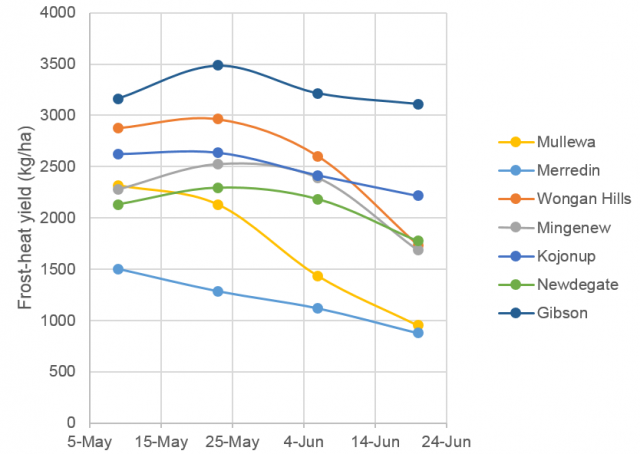
Figure 1 shows likely yields but says little about the distribution on either side of the median. Figure 2 (a-g) show the probability of achieving different yields at each location. The chance of getting over 1.5t/ha at Mullewa or Merredin declines very rapidly as sowing extends into June, but remains reasonable at other locations. The chance of getting 2t/ha at Kojonup and 3t/ha at Gibson remains reasonable even with late June sowings.

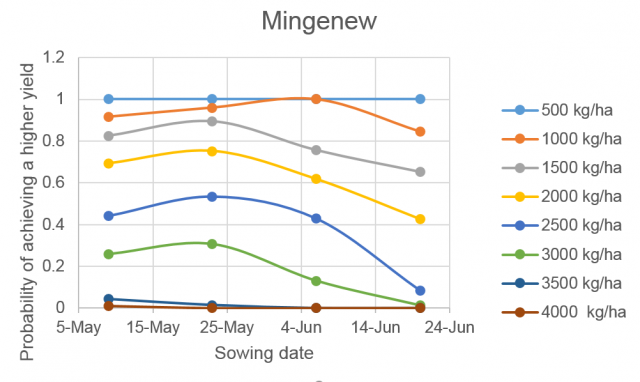
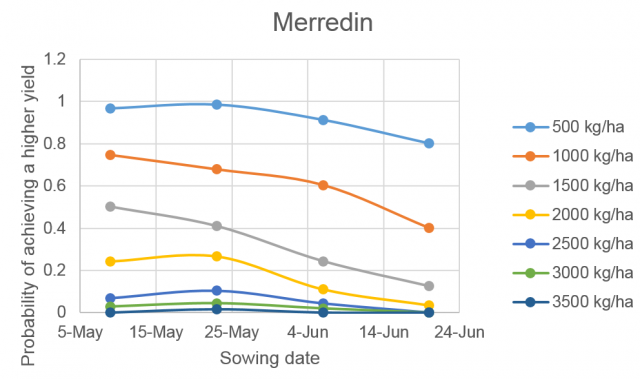
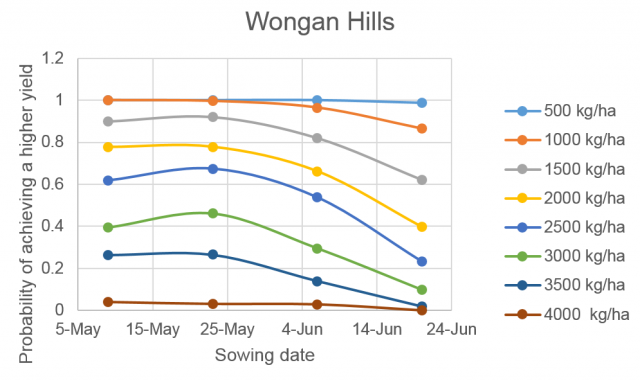
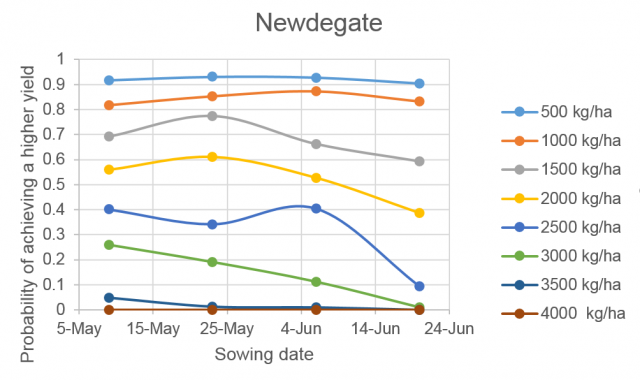
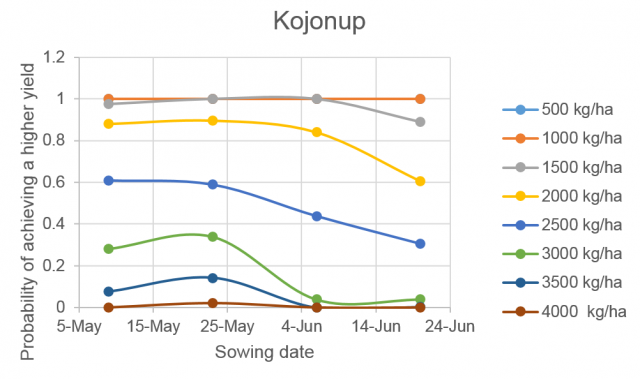

Obviously the actual yield will depend on conditions for the remainder of the growing season. The simulations assume the same distribution of rainfall and temperature at each location as has occurred over the past 43 years. Information on the likelihood of wetter or drier conditions during the 2019 growing season could be used to adjust expected yields up or down.
Information on expected yield and the probability of achieving higher yield can assist with management options for 2019.
For paddocks already sown
- They will emerge on opening rains and provide the best yielding option for short-medium maturity wheat. Note that an effective sowing date 7 or 8 days earlier than the emergence date should be used to assess the likely yield of a dry sown crop in the figures above.
- Consider implications of dry soil on herbicide longevity and consequent weed issues.
- Consider likely yield when making top-up fertiliser decisions.
For paddocks not sown
- Yield potential is declining and probability of yields over 2t/ha are declining in most locations
- Consider locking up paddocks if they are not already sown in low rainfall districts
- If you have ameliorated your soil – it will be important to consider establishing a cover crop on those paddocks to maintain stubble cover and prevent erosion in the following year.
References
- Shackley, B., Zaicou-Kunesch, C., Curry, J. and Nicol, D (2019) Which Wheats For When? Presented at GRDC Research Updates, Perth Western Australia 2019
- Department of Primary Industries and Regional Development, WA (2019) Seasonal Climate Outlook ISSN 2203-076
